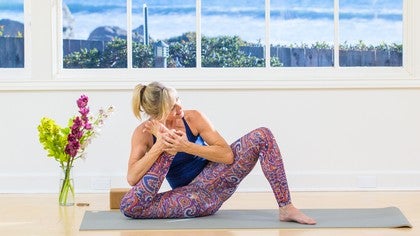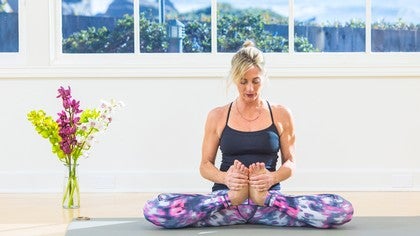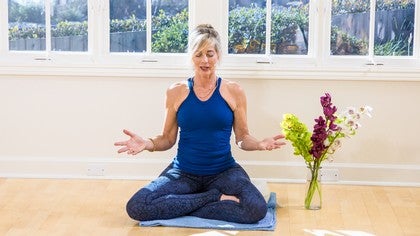Description
About This Video
Transcript
Read Full Transcript
So this practice is dedicated to creating a sense of spaciousness in the body. And my hope is that you have been through the first video on stability and the second video on ease. And the third one on attention and using our energy well. And the fourth one on movement. And sense of lightness.
And now we move to spaciousness which sort of lives as the backdrop for those for other principles. We talk a lot in yoga about creating space in the body and a lot of that is because especially as adults, what we do during the day whether we like it or not is that we accumulate, we accumulate, experiences in the body that stay with us and so part of the practice is dedicated to releasing those experiences from the body so that they don't weigh down or fire us up or take us to places we don't want to go in our mind. So as we're practicing today I'd like us to all remember that space is really the backdrop for the entire experience. Step ourselves off the planet, look back at the planet, there's a whole lot of space. Go inside the body and what are you gonna find?
You're gonna find space inside this body, in fact, we're largely made up of space. We're looking at the top of the inhale and the bottom of the exhale for a natural pause and space. And we're also looking at the space between our thoughts. There's this lovely space right in there. And in that space eventually as yogis we're looking to extend that space so that we can just be.
this practice is dedicated to just being. Okay? So let's begin, namaste. So first off, we're seated and you may find if you're seated like this that your knees are really up high and if that's the case it might be nice to get a pillow or a cushion underneath your hips or have one nearby because it will help you immensely as we move into the practice. Alright so we're gonna come down on to our backs.
Just draw the knees into the chest, give yourself a hug here. And almost as if we're beginning in child's pose except we're on our back. Same kind of practice, we wanna acknowledge the things that are there inside the body today that are actually in the way of spaciousness so notice any reverberations in the body, any strong sensations that you feel. Any concerns that you tend to continue to repeat in your mind, in your thoughts. And then notice the breath, notice where the breath is going in the body.
And can you feel the belly expand? Can you feel the rib cage expand and release? And can you feel the top chest area? Then when you're ready go ahead. Take the legs wide, we're gonna come into happy baby, some of you it might be easier to grasp the ankles or slowly bringing the hands around the feet if that's possible.
And then allow the tailbone and the pelvis to draw downward. Feel the weight of the thigh bones. Sometimes people will tend to keep the shoulders rounded so if you can just allow the shoulder girdle to relax. And breathing in and out through the nose the breath goes wide in the body. As if you could fan the breath out into the legs and side body.
And just watch the breath here, notice if you can find that pause at the top of the inhale. And a pause at the bottom of the exhale. But nothing forced. You can just notice what we notice, it's the noticing actually that creates more space, it's just bringing more attention and in of itself creates more space. Inhale here.
Exhale, go ahead and bring the legs back in, give yourself a hug. And then out of curiosity we're gonna bring the left ankle across the front of the right thigh keeping the foot flexed. The deal here is that if the knee turns in, likely the hip has got some tightness in it, there's an external rotation of this thigh bone that we're looking for. I like to just grasp the thigh and roll it. No pushing here.
So just go where you can and then take the hands through to the back of the thigh or the front of the shin. Then allow the arm bones to become heavy again, some of you might take your left elbow pushing into the inner left thigh. And this practice, this posture in of itself is really helpful for many people who've got lower back issues. And so you slowly take your attention inward. And notice where you feel sensation.
It's often the case that if we feel sensation that we interpret as being something we don't wanna feel some of kind aversion, we sort of run from it. But we're gonna treat the sensation like an old friend that we haven't seen for a long time. And we know that we care, we just gotta find our way back in so we gotta slowly approach the sensation with our awareness. And watch as we saw in the last video, things change quickly. So what is constant is changed.
And if we make a decision about what we feel, often we miss. We miss the change. Inhale here, exhale let's release the left leg. Good and crossing, coming to the other side. Good so never taking one side or the other for granted, they really, there's something often referred to as the myth of symmetry.
We're very interested in symmetry in this practice. But indeed it is a myth. We work toward it without being attached to it. This side could be entirely different than the other. Good, begin the slow approach.
In towards sensation. And then watch it, maybe this is exaggerated but like a fireworks display, you know, you're looking up at the sky. And there's this sort of joy or excitement at the fireworks and then they dissipate then a new one comes. And it is like that with sensation. All worthy of our attention.
Inhale here. Exhale, let's release that leg. And let's go ahead and put both feet down for a moment there hip with the part. Take your arms wide, just let the legs cascade over to the right. And to the left.
Now we just go back and forth here so I decided quite easily. Good and then come back to center. And we'll extend the left leg long. And then the left foot will remain flexed, the toes point upward. Bring the right knee into the chest.
And we're gonna grasp the right big toe and extend the leg and you're gonna now know whether or not you need to have a strap around the foot. This right hip will wanna encroach, it'll wanna rise up, just extend the right hip back, remember the relationship between the inner thighs. And then allow this right shoulder to sink downward. Keeping both feet flexed, it's helpful to have the left hand on top of your left thigh if you find that the hip wants to begin to rise. And then explore.
Explore the body. The physical sensations. Explore the breath. How the breath moves in this shape. And then watch the mind.
Like we're looking up at the sky and there are clouds. They come and they go. Inhale here. Exhale. With your left hand on your left thigh, pushing down a little bit, take the leg out to the side.
Good, I like to imagine that I have an elastic cord between the two feet. So both legs are still quite dynamic here. I push out through the left heel. My shoulder blades are down. I might turn my gaze to the left slightly.
And once again, the exploration begins. You might notice the inner right thigh. And then the inner left thigh. You might notice that you could drop and weight the left pelvis. You might notice the jaw.
Can the jaw be softer? Allow the body to be supported by the ground. Three more breaths here. Good, now root your left leg. Inhale.
Bring your right leg back up. Exhale. Remember when we had this figure four, go ahead and take hold of your foot with your left hand. And draw your shin keeping this flexed, draw your shin towards your chest. Just pause here, we're gonna keep this low, this shin bone is low to the chest, as low as works for you.
Remember this right thigh, the external rotation of the right thigh, sometimes that helps to support you. Now, I happen to be fortunate because I've got a wall back here, I'm gonna imagine that I'm pushing into the wall, I'm keeping the shin low and I'm slowly, slowly pushing into the wall. And I can tell you that what's gonna wanna happen is your right hip's gonna wanna lift up. If you can take your thumb and put it in the hip crease and push down on the hip crease, keep it low. Low and move slowly.
So we don't wanna miss anything. I often say, don't miss this, don't miss all that sensation that you feel in there. And use your breath so the inhale inflates that sensation. Alright so when we're struck with anger or aversion or attachment, we want things to be a certain way. And all that holding.
Two ways to deal with it, we can release, which is easier said then done or we can go in and look at what the source of that holding is. So in this case, we're using this as a metaphor, we go in, we feel the holding. And we really feel it, really feel it. And then watch as we really feel. It's like watching dispassionately, slowly, slowly the foot pushes.
Check the hip crease. Notice the breath, the breath is still fluid. Inhale here, you've come all the way out now. Exhale slowly, bring the leg back. And release it to the floor.
Turn the palms up. And receive the benefits of that series of movements. Good, I'm hoping that it was as good for you as it was for me. Now, the right leg. We keep it down.
Draw the left knee in. Grasp the big toe if appropriate or wrap your strap and extend. Let the left shoulder sink, extend through the heel, wake up your right foot, the foot is far away from the brain so it's the first thing to forget. Good, look for length. So all those principles that we've been implying throughout our practice together, we've got the stability of the bones dropping.
We've got the ease of the outer body. We have our attention everywhere in the body at the same time. Good, we're able to direct our attention in any given place. The breath is free. Inhale, exhale, extend the left leg out to the side.
Rooting the right thigh bone down. Good, remember the elastic cord between the feet. And then as we watch the breath here, remember that space at the top of the inhale. And the bottom of the exhale. So if you've ever taken art classes or drawing classes you'll remember that there's a lot of discussion around negative space.
So we will see like these flowers, we see the flowers, but we're as interested in the space around the flowers as we are the flowers themselves and it's much like that here in the body. We're interested in the space behind and between as much as the experience, the phenomenon that are taking place. Inhale, lift the left leg all the way back up. Good and then bend the knee. Keep your left foot flexed, draw the shin toward the chest.
Keep it low, you might take your left thumb now to the hip crease. And it's as low as you can comfortably go here. Foot's flexed, right foot's flexed, begin to push. Push now there will be a tendency likely to go fast through the gnarly bits. Check your hip crease, drop it.
And stay with. Good the right leg, the toes continue to turn up if they can, if they roll out, no big deal. And we're just slowly push, and push and push, take hold of the foot again. And drop the hip. If you get to a place where there's a lot of tension, hang out there for a minute.
Take a few breaths. Inhale here. Exhaling, we gradually come back. And release the left leg, pause. And notice what that's like.
This is great for after work if you've been sitting all day. Well let's slide the feet in. Send the right arm up over the head, roll to the right. And with the left hand, gradually rise up. We're gonna come to a seated position on the mat.
Let's take the legs forward first. Bring the right knee in close. Then roll the leg out to the side. Now I'm gonna offer this as your first variation. Because the second variation that I'm gonna offer, nobody will want to do, it's challenging.
And there's plenty of sensation. But ultimately it's to our benefit if we're willing to go and navigate that sensation. So you can always rely on janu sirsasana. Or you're gonna bring the shin close to the chest. Now here's how it works, left hand grasps right ankle.
Right arm slides in underneath. Hand grasps the ball of the right foot. We're gonna turn the foot down toward the ground. Okay. So I like to take my hands back.
You're gonna be careful with this knee if you have knee issues. Pay attention. Slide forward a little bit so that the heel is making its way over the ball of the foot. Plenty of sensation there. Left foot is flexed.
Drop the right sit bone to the best of your ability. Inhale, lengthen. Exhale, we fold forward. Fold forward. We're slow, we're slow about this because this is not a move that we take all that often.
And it is oh so good for the fascia on the sole of the foot. We employ all those same principles. Stability. Ease. Attention.
Breath. And being. We're being here right now. Inhale, rise up. Exhale, send the right leg out.
Good, just notice the new space that becomes quite evident in the right leg. And left foot comes in. And we roll out. Now I should mention that for those of us, let's see it's janu sirsasana and your knee is high, you may find that there's some pain here in the knee. Nice to block it, nice to block it.
So go ahead, take the shin to the chest if you wish. You're forward on your sit bones. Take your left arm through. Grasp the ball of the foot and this is a tricky move. The toes are wide.
Put the foot down on the ground. Good, take the hands back behind. Slide in. Good, sometimes the knee will be high, just allow the knee to drop where it will. Good, inhaling.
Exhaling, folding forward slowly. In the exhale, especially in forward fold, the exhales a little bit longer. The exhale helps us. Helps us to let go and release. And gradually, let's make our way out.
Good, release the left leg long. Okay. Wonderful. So from here let's bring both knees into the chest. Soles of the feet come together, the knees go wide.
If the knees are high this is where you wanna be able to sit up on something. Because ideally the knees and the hips are in the same plane. Okay. So you can slide the heels in. Or you can lift the pelvis up and slide in closer to the heels.
We'll inhale, lengthen the spine. Exhale, keep your root, keep your sit bones rooted to the floor and begin to fold forward. So, now we've talked about zippers a lot in the body, we're gonna have zippers along the side body. Side body long. Rib cage moves away from the pelvis.
But the pelvis stays rooted. Use your exhale to your advantage. Become keenly aware of everything you feel internally. Just observing. Hands slide under the shoulders, inhale, rise up.
And take hold of your feet. And this works for some of us and not well for others at all so no worries if it doesn't work, you're just gonna attempt to roll the feet open. It is often said like a book. And then press the outside of the feet in toward one another. And see if the feet will come off the floor, that will happen or it won't.
Because we're practicing spaciousness, we're not attached either way. I'm just noticing what this body does. It's totally fascinating, what does your body do? Slowly the feet come in toward the chest. Use your mid-back to help support lifting up.
Again, inhale here. Exhale. And release. Okay so let's take the hands to the knees, just draw the legs in. And we'll turn and we're gonna come right back down onto our backs once again.
And take your legs straight up. Good, so as you're looking at your toes, look at the spaces between the toes. And then notice the space on the inside of the thighs. The shape that's made there. And flex your feet.
And then slowly allow the legs to drift over the torso. Then your legs may stop here so just go where the legs go. So you might not be taking plow pose, so we're gonna use plow pose to help us with our next, with where we're going next. But if you're not inverting today then this is where you can remain, right here. If you're going on, just allow the tailbone to lift off.
And we'll take the legs back behind us. Slide the shoulder blades in. Lift the pelvis up. Remember now we're creating space. Lengthening the side body.
Moving the front thighs up and away. Lots of space being made at the thoracic spine. And then go ahead and let one knee at a time come around your ears. The shins will land or they won't. And we let the shin bones get heavy.
The sit bones lift up. And we notice that the breath is impeded in this posture. But you notice that the spaciousness of the mind remains unimpeded where it just simply observing our experience here. There's all those sensations. There's thoughts that rise and pass.
And there is the breath. And we're observing. Now you could tuck the toes under. And just lift back into plow pose and then let the legs float above you. You could place your hands on your hips.
Bend your knees a little bit. What we're kinda curious about and those of you who are down with your backs on the ground, you're gonna do this here. But what we're curious about is can you bring the foot to the front of the left thigh. The foot's flexed, that's the information that we're gathering right now. What happens when we bend the knee and bring the foot in and can we walk the foot to the hip crease?
Again, we've got this big external rotation of the right thigh bone. Good then send that one out and then see what happens on this other side bringing the foot to the front of the thigh. Good and then release. And we're all gonna find our way now onto our back. So because of gravity one of the easiest ways to explore padmasana is with the legs up over the torso.
So if you prefer to try it with the legs up here be my guest. Otherwise the foot will come to the thigh. And have it be the right foot and tuck the foot in close to the hip crease. And this is the big deal here, this left thigh has got to externally rotate. So that the left foot can come over the right thigh.
Okay the feet are flexed. The big deal with padmasana is that many people are not open enough in the hips. And that results in not enough external rotation of the thigh bone so that the meniscus here gets pinched because these two bones, this whole leg has not externally rotated enough so we wanna be sure to maintain that space. If it's not happening today then just put your foot behind. And hold here.
Or like this. Or like this. And when you make those choices, notice well, there's some sensation, good go ahead toward the sensation gently. Because that's where our work is. So if we're in padmasana just give your padmasana a hug.
If you wanna get fancy about it, you can take the legs back up. Slide the blades under. Send the sit bones up. And maybe the arms come to the knees, the feet are flexed. Lift the sit bones.
Good, drop the legs. Wrap your arms around your legs. Good, arms down. Legs come down. Good you can grasp your feet.
And this is a interesting challenge, you can see if you're in padmasana, will the legs slowly make their way toward the floor? Sometimes the hip flexers are really tight here. So go where you can go. Hands might come around the feet. Press the elbows into the floor.
Lift the chest. Inhale here. Exhale slowly release. Unwind your legs. Give yourself a hug.
Good, right arm up over the head. Roll. And slowly rise up. Alright so now we have lots of information. We've got this right leg.
The foot could come to the left hip crease. Remember this rolls out, this rolls out. That's usually the easier leg. The problem here is that we've got this leg in the way and this foot's gotta come over the leg. This rolls out, this rolls out and the foot comes over or it doesn't.
And if it doesn't we're patient. Okay. So sit in padmasana or half padmasana or a comfortable seat. Close the eyes, we'll turn the palms face up. Drop the sit bones.
Soften the outside of the body. Become aware of the whole body at once. Notice the body being breathed. Notice the mind being thought. All of those thoughts arise and pass.
And we're here for all of it. And the way it works is we're here and we're here. And we're here. No place I'd rather be. So let's bring the palms together at the heart and just open your eyes for a moment.
You've probably noticed that the lotus is a huge symbol for yoga. This opening, the rising up through the muddy waters. The muddy waters of all this stuff that we work with in our lives all the time. And then the blooming and the blooming is a statement of being here and here and here. So my wish for you, is that through this practice your ability to strengthen your capacity to stay right there, present, open, fully fully aware and alive and vital.
That that remain with you all the time, that's what we have, we have this practice to rely on, to bring us back to appreciating each moment. So let's bring our hands to our forehead, right thought may we be steady and present and joyful. The hands come to the mouth, right speech, may our words improve upon the silence. And our hands come to our heart right action. May we be the change that we wish to see.
Namaste.
Mandala Yoga
Comments

You need to be a subscriber to post a comment.
Please Log In or Create an Account to start your free trial.













